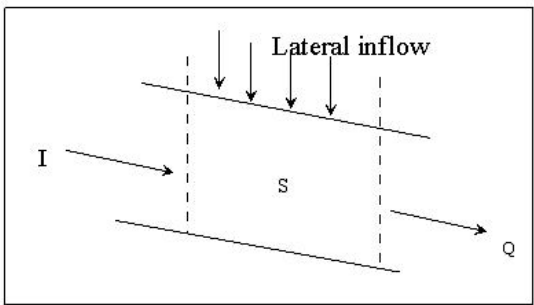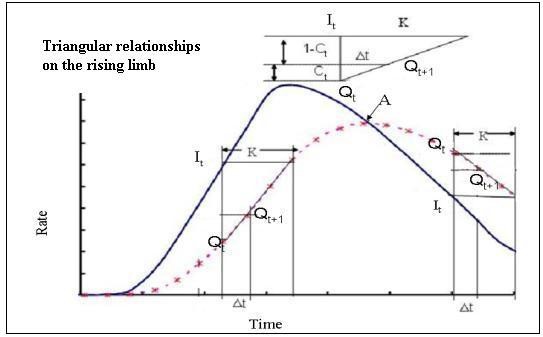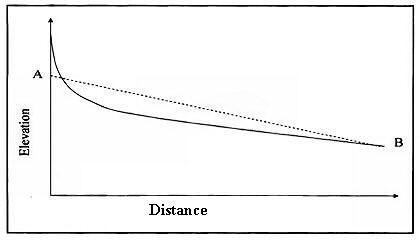2.1 The Basic Muskingum Flood Routing Method
Typically, the inflow hydrograph used in flood routing is derived by converting a measured stage into discharge using a steady state rating curve (Mutreja, 1986; Perumal and Raju, 1998; Moramarco and Singh, 2001).
As illustrated by Shaw (1994), storage in a river reach can be categorized into three forms, as depicted in Figure 2.1. During the rising stage of a flood in the reach, when inflow exceeds outflow, wedge storage must be added to prism storage. Conversely, during the falling stage, when inflow is less than outflow, wedge storage is negative and subtracted from prism storage to calculate total temporary storage in the reach. When outflow and inflow are equal in a reach, only prism storage is present in the channel.

Figure 2.1 Storage and non-steady flow (after Shaw, 1994).
Figure 2.2 illustrates an example of inflow and outflow hydrographs to and from a reach with prism storage. In a river reach characterized by a uniform cross-section and constant slope, velocity remains unchanged, indicating uniform flow (Chow, 1959). In these reaches, the peak of the outflow hydrograph aligns with the recession curve of the inflow hydrograph (Shaw, 1994).
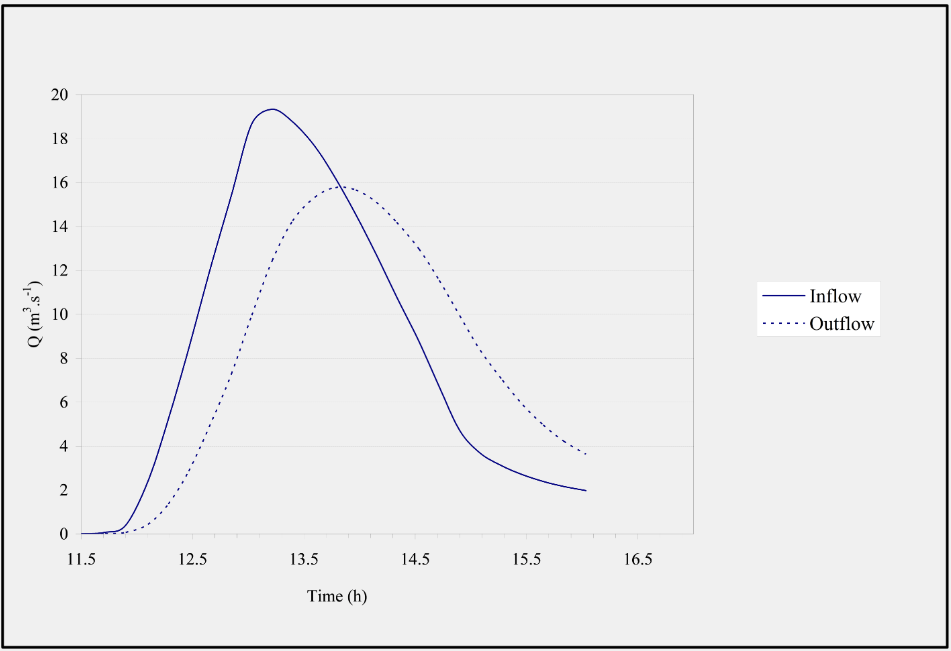
Figure 2.2 Example of inflow and outflow hydrographs.
According to Tung (1985) and Fread (1993), the most common form of the linear Muskingum model is expressed as the following equations:
Sp = KQt (2.1)
Sw = K (It - Qt)X (2.2)
| Sp | = | temporary prism storage [m3], |
|---|---|---|
| Sw | = | temporary wedge storage [m3], |
| It | = | the rate of inflow [m3/s] at time = t, |
| Qt | = | outflow [m3/s] at time = t, |
| K | = | the storage time constant for the river reach which has a value close to the wave travel time within the river reach [s], and |
| X | = | a weighting factor varying between 0 and 0.5 [dimensionless]. |
By combining Equations 2.1 and 2.2, the basic Muskingum equation is attained as given in Equations 2.3a and 2.3b:
St = St + Sw (2.3a)
St = K [X It + (1 - X) Qt] (2.3b)
| St | = | temporary channel storage in [m3] at time t, |
|---|---|---|
| Sp | = | prism storage at a time t, and |
| Sw | = | wedge storage at a time t. |
When X = 0, Equation 2.3 simplifies to St = KQt, indicating that storage is solely dependent on outflow. When X = 0.5, equal weight is given to inflow and outflow, resulting in a condition akin to a uniformly progressive wave that does not attenuate (US Army Corps of Engineers, 1994a). Thus, 0.0 and 0.5 serve as limits for the value of X, determining the degree of attenuation of a flood wave within this range as it passes through the routing reach (US Army Corps of Engineers, 1994a).
Fread (1993) explained that an oversimplified depiction of unsteady flow along a routing reach may be seen as a lumped process, wherein the inflow at the upstream end and the outflow at the downstream end of the reach vary with time. In Muskingum flood routing, it is assumed that the storage in the system at any moment is proportionate to a weighted average of inflow and outflow from a given reach (Bauer, 1975).
According to the continuity equation (Equation 2.4), the rate of change of storage in a channel over time equals the difference between inflow and outflow (Shaw, 1994):
ΔSt/Δt = It - Qt(2.4)
| ΔSt/Δt | = | the rate of change of channel storage with respect to time. |
|---|
The combination and solution of Equations 2.3 and 2.4 in finite difference form yield the well-known Muskingum flow routing equations as presented in Equations 2.5 and 2.6.
Qj+1t+1 = C0 Ijt + C1 Ijt+1 + C1Ij+1t(2.5)
| Qjt | = | outflow at time [t] of the jth sub-reach, and |
|---|---|---|
| Ijt | = | inflow at time [t] of the jth sub-reach. |
The three coefficients (C0, C1, and C2) are calculated as:
C0 = (Δt + 2KX) / m (2.6a)
C1 = (Δt - 2KX) / m (2.6b)
C2 = (2K(1-X) - Δt) / m (2.6c)
m = 2K(1-X) + Δt (2.6d)
Δt/K > 2X (2.7)
| K | = | change in time [s], |
|---|---|---|
| Ijt | = | the storage time constant for the river reach, which has a value close to the wave travel time within the river reach [s], and |
| X | = | a weighting factor varying between 0 and 0.5 [dimensionless]. |
After the X parameter is determined, the routing time interval should be checked again using the relationship shown in Figure 2.3 (Cunge, 1969; cited by NERC, 1975).
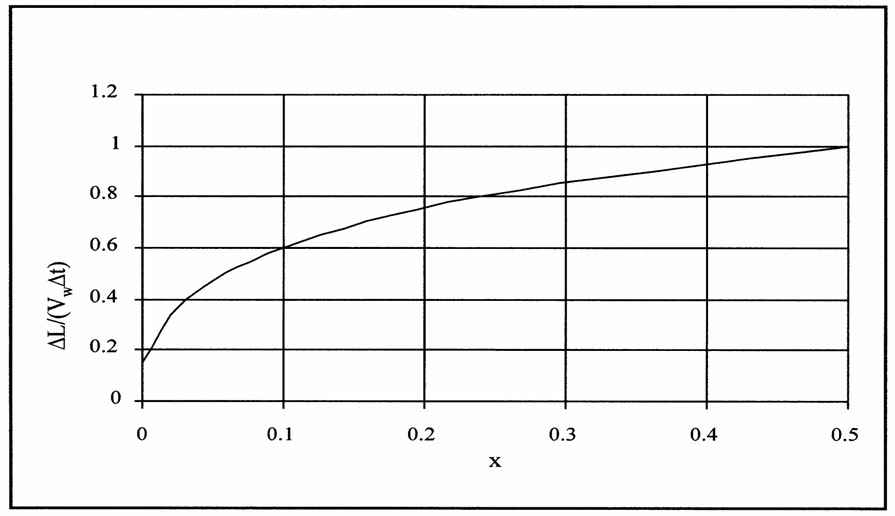
Figure 2.3 Cunge curve (Cunge, 1969 cited by NERC, 1975).
The time Δt is called the routing period and it must be chosen sufficiently small such that the assumption of flow rate linearity over time interval Δt is approximated (Gill, 1992). In particular, if Δt is too large, the peak of the inflow curve may be missed, so the period should be kept smaller than 1/5 of the travel time of the flood peak through the reach (Wilson, 1990). According to Viessman et al. (1989), theoretical stability of the numerical method is accomplished if Equation 2.8 is fulfilled:
2KX <= Δt <= 2K(1-X) (2.8)
Viessman et al. (1989) and Fread (1993) noted that the routing time interval (Δt) is frequently assigned any convenient value between the limits of (K/3) <= Δt <= K. Analysis of numerous flood waves suggests that the time taken for the flood wave's center of mass to traverse from the reach's upstream to downstream end equals K.(Viessman et al., 1989). The value of K can thus be estimated using gauged inflow and outflow data and with much greater ease and certainty than that of the X parameter (Viessman et al., 1989; Wilson, 1990). Among other factors in a catchment that influence the travel time (K), the most important are: drainage pattern, surface geology, soil type, catchment shape, and vegetal cover (Bauer and Midgley, 1974). None of these are readily expressible numerically, but to a large extent the factors are interdependent and can be generalized on a regional basis (Bauer and Midgley, 1974). Most researchers agree that the effectiveness of the Muskingum flood routing method depends on the accuracy of estimation of the K and X parameters (Singh and McCann, 1980; Wilson and Ruffin, 1988).
In order to determine the K and X parameters using observed inflow and outflow hydrographs, Equation 2.5 is used (Shaw, 1994). If observed inflow and outflow hydrographs are available for the reach, and When observed inflow and outflow hydrographs are accessible for the reach, and considering St and [XIt + (1-X) Qt] are assumed to be related via Equation 2.3, a graphical procedure to estimate K and X parameters may be implemented by assuming different values of X (Chow et al., 1988). The accepted value of X will then be that value of X that gives the best linear and narrowest loop (Gill, 1978; Fread, 1993). For example, in Figure 2.4, K is taken as the slope of the straight line of the narrowest loop X = 0.3 (Heggen, 1984). The shortcomings of the graphical method include the time required to construct the plots for alternative Xs, visual subjectivity, and the sensitivity of X in short reaches (Heggen, 1984; O'Donnell et al., 1988; Gelegenis and Sergio, 2000).
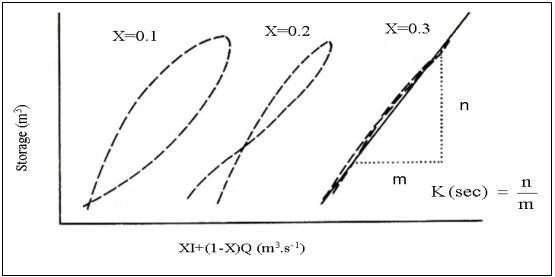
Figure 2.4 River routing storage loops (after Wilson, 1990).
The peak outflow does not lie on the inflow recession curve due to the effect of the wedge storage in streams (Shaw, 1994). As shown in Figure 2.5, the simulated outflow hydrograph is not a good reconstruction of the observed outflow. This discrepancy may arise when the relationships outlined in Equation 2.8, governing the interplay between K, X, and Δt, are not met (Gill, 1992).
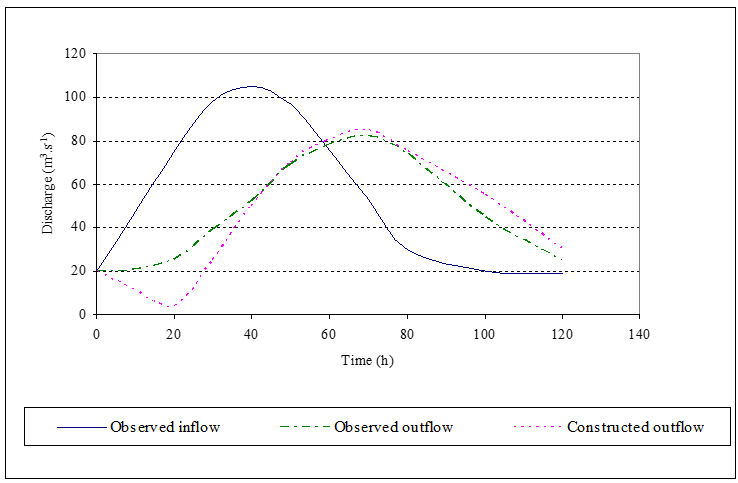
Figure 2.5 Muskingum routed hydrographs (after Shaw, 1994).
The basic Muskingum equation formulation is applicable to a single reach having no lateral inflow into the routing reach (Choudhury et al., 2002). In most rivers, this constrains the routing reaches to be rather short, generally terminating at tributaries, and requires gauged or estimated tributary inflows to be added to the main channel flow (O'Donnell, 1985). If there is lateral inflow in the form of substantial tributaries, the routing reaches may be chosen to terminate at a confluence, augmenting the main channel flow by the tributary flow for the next reach (O'Donnell, 1985). As explained by Fread (1993) and the US Army Corps of Engineers (1994a), the original Muskingum method is limited to moderate to slow rising hydrographs being routed through mild to steep sloping channels. The method is not applicable to steeply rising hydrographs such as dam breaks and ice breaks, where acceleration and momentum predominate, and the method neglects variable backwater effects such as downstream dams, constrictions, bridges and tidal influences (O'Donnell et al., 1988; Gelegenis and Sergio, 2000).
One of the disadvantages with hydrological methods of flow routing is that they assume a unique relationship between stage and discharge along the reach, even though the same discharge may have different flood levels at rising and falling stages (NERC, 1975). This phenomenon is indicated graphically in the well-known loop-rating curve as shown in Figure 2.6.
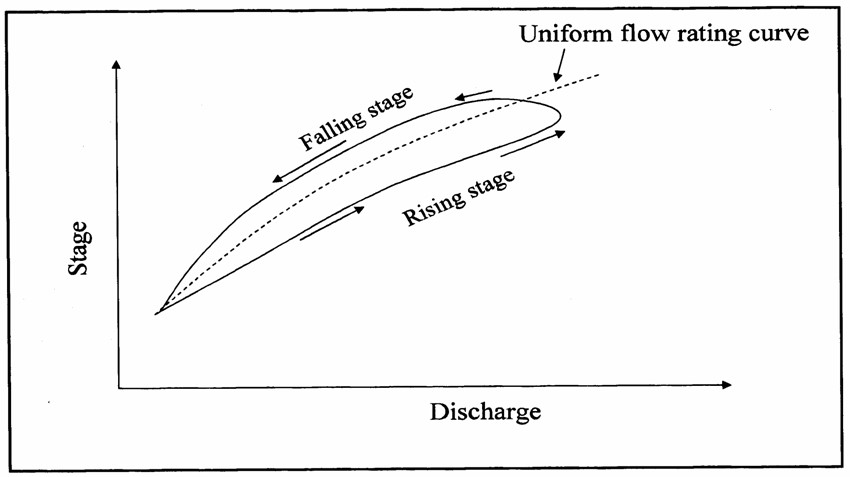
Figure 2.6 Loop-rating curve (after NERC, 1975).
